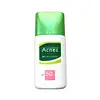What's inside
What's inside
 Key Ingredients
Key Ingredients

 Benefits
Benefits

 Concerns
Concerns

No concerns
 Ingredients Side-by-side
Ingredients Side-by-side

Cyclopentasiloxane
EmollientWater
Skin ConditioningGlycereth-18 Ethylhexanoate
Skin ConditioningZinc Oxide
Cosmetic ColorantPhthalic Anhydride
PEG-8 Dimethicone
EmulsifyingTitanium Dioxide
Cosmetic ColorantTalc
AbrasiveMica
Cosmetic ColorantAluminum Hydroxide
EmollientDimethicone
EmollientButylene Glycol
HumectantGlycerin
HumectantTrimethylsiloxysilicate
EmollientCetyl PEG/PPG-10/1 Dimethicone
EmulsifyingVinyldimethicone
Dimethicone/Silsesquioxane Copolymer
CI 77492
Cosmetic ColorantO-Cymen-5-Ol
AntimicrobialTocopheryl Acetate
AntioxidantRosmarinus Officinalis Extract
AntimicrobialStearyl Glycyrrhetinate
Skin ConditioningMagnesium Sulfate
Parfum
MaskingCI 77491
Cosmetic ColorantCI 77499
Cosmetic ColorantPyridoxine Hcl
Skin ConditioningMagnesium Ascorbyl Phosphate
AntioxidantCyclopentasiloxane, Water, Glycereth-18 Ethylhexanoate, Zinc Oxide, Phthalic Anhydride, PEG-8 Dimethicone, Titanium Dioxide, Talc, Mica, Aluminum Hydroxide, Dimethicone, Butylene Glycol, Glycerin, Trimethylsiloxysilicate, Cetyl PEG/PPG-10/1 Dimethicone, Vinyldimethicone, Dimethicone/Silsesquioxane Copolymer, CI 77492, O-Cymen-5-Ol, Tocopheryl Acetate, Rosmarinus Officinalis Extract, Stearyl Glycyrrhetinate, Magnesium Sulfate, Parfum, CI 77491, CI 77499, Pyridoxine Hcl, Magnesium Ascorbyl Phosphate
Water
Skin ConditioningCyclopentasiloxane
EmollientPhenylbenzimidazole Sulfonic Acid
UV AbsorberGlycerin
HumectantCentella Asiatica Leaf Water
Skin ConditioningDimethicone
EmollientTromethamine
BufferingPolyphenylsilsesquioxane
Terephthalylidene Dicamphor Sulfonic Acid
UV AbsorberVinyl Dimethicone
Panthenol
Skin ConditioningPEG/PPG-17/6 Copolymer
SolventDimethicone/Vinyl Dimethicone Crosspolymer
Skin ConditioningGlyceryl Glucoside
HumectantDimethicone/PEG-10/15 Crosspolymer
PEG-10 Dimethicone
Skin ConditioningHexylene Glycol
EmulsifyingHydroxyacetophenone
AntioxidantDipotassium Glycyrrhizate
HumectantDipropylene Glycol
HumectantSodium Citrate
BufferingTocopherol
AntioxidantArtemisia Vulgaris Extract
Skin Conditioning1,2-Hexanediol
Skin ConditioningWater, Cyclopentasiloxane, Phenylbenzimidazole Sulfonic Acid, Glycerin, Centella Asiatica Leaf Water, Dimethicone, Tromethamine, Polyphenylsilsesquioxane, Terephthalylidene Dicamphor Sulfonic Acid, Vinyl Dimethicone, Panthenol, PEG/PPG-17/6 Copolymer, Dimethicone/Vinyl Dimethicone Crosspolymer, Glyceryl Glucoside, Dimethicone/PEG-10/15 Crosspolymer, PEG-10 Dimethicone, Hexylene Glycol, Hydroxyacetophenone, Dipotassium Glycyrrhizate, Dipropylene Glycol, Sodium Citrate, Tocopherol, Artemisia Vulgaris Extract, 1,2-Hexanediol
Ingredients Explained
These ingredients are found in both products.
Ingredients higher up in an ingredient list are typically present in a larger amount.
Cyclopentasiloxane, or D5, is a silicone used to improve texture of products and trap moisture.
D5 is considered lightweight and volatile. Volatile means it evaporates quickly after application. Once evaporated, D5 leaves a thin barrier that helps keep skin hydrated.
It is also an emollient. Emollients help soften the skin and prevent water loss. Silicones create a silky texture in products. D5 helps other ingredients become more spreadable.
Studies show D5 is safe to use in skincare products. We recommend speaking with a skincare professional if you have concerns.
Learn more about CyclopentasiloxaneDimethicone is a type of synthetic silicone created from natural materials such as quartz.
What it does:
Dimethicone comes in different viscosities:
Depending on the viscosity, dimethicone has different properties.
Ingredients lists don't always show which type is used, so we recommend reaching out to the brand if you have questions about the viscosity.
This ingredient is unlikely to cause irritation because it does not get absorbed into skin. However, people with silicone allergies should be careful about using this ingredient.
Note: Dimethicone may contribute to pilling. This is because it is not oil or water soluble, so pilling may occur when layered with products. When mixed with heavy oils in a formula, the outcome is also quite greasy.
Learn more about DimethiconeGlycerin is already naturally found in your skin. It helps moisturize and protect your skin.
A study from 2016 found glycerin to be more effective as a humectant than AHAs and hyaluronic acid.
As a humectant, it helps the skin stay hydrated by pulling moisture to your skin. The low molecular weight of glycerin allows it to pull moisture into the deeper layers of your skin.
Hydrated skin improves your skin barrier; Your skin barrier helps protect against irritants and bacteria.
Glycerin has also been found to have antimicrobial and antiviral properties. Due to these properties, glycerin is often used in wound and burn treatments.
In cosmetics, glycerin is usually derived from plants such as soybean or palm. However, it can also be sourced from animals, such as tallow or animal fat.
This ingredient is organic, colorless, odorless, and non-toxic.
Glycerin is the name for this ingredient in American English. British English uses Glycerol/Glycerine.
Learn more about GlycerinWater. It's the most common cosmetic ingredient of all. You'll usually see it at the top of ingredient lists, meaning that it makes up the largest part of the product.
So why is it so popular? Water most often acts as a solvent - this means that it helps dissolve other ingredients into the formulation.
You'll also recognize water as that liquid we all need to stay alive. If you see this, drink a glass of water. Stay hydrated!
Learn more about Water